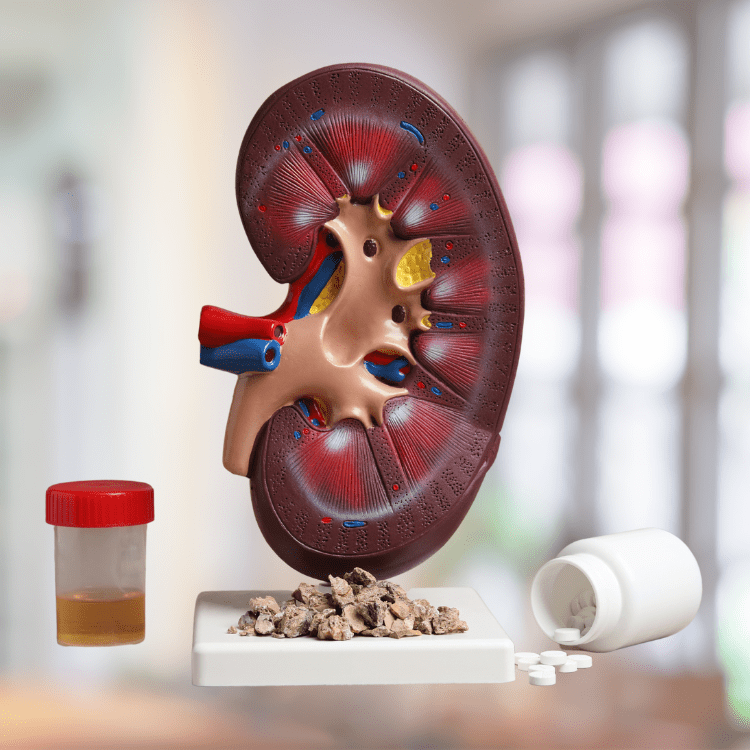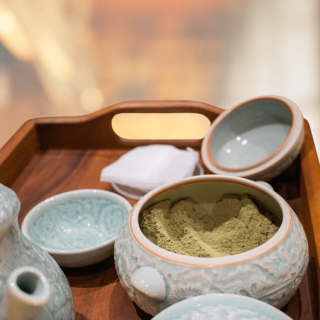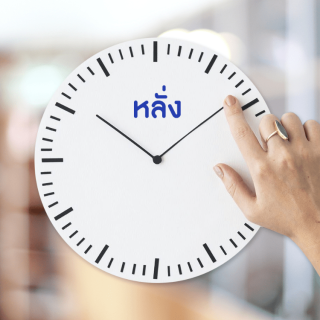
Urinary System
Urinary stone
Ureteric Stone is a common disease, especially urinary tract stones (Ureteric Stone), which are calcium deposits inside the kidney or bladder. The urinary system starts from the two kidneys at the back of the ribs and has a ureteric tube down to the bladder. Most stones occur in the kidneys and flow down. They may be stuck in the ureters. Stones in the ureters are called ureteric stones or, if they are small, they will continue to flow out with urine. Stones are common in people of all ages, but are more common in men than women. They are most common in the age group of 30-40 years. In Thailand, they are most common in the North and Northeast. Stones can be of various sizes. There may be only one stone or many stones. Most often, they occur in only one kidney, but sometimes both kidneys may occur. In some cases, they may occur repeatedly. Urinary Stones are a common disease, especially urinary tract stones, which are calcium deposits inside the kidney or bladder. The urinary system starts from the two kidneys at the back of the ribs and has a ureteric tube down to the bladder. Most stones occur in the kidney and flow down. They may get stuck in the ureter. Stones in the ureter are called ureteric stones or if they are small, they will continue to flow down until they come out with the urine. Kidney stones are common in people of all ages, but they are more common in men than women and are most common in the 30-40 age group. In Thailand, they are most common in the North and Northeast. The stones can be of different sizes. There may be only one stone or many stones. Most often, they occur in only one kidney or both kidneys. In some cases, they may occur repeatedly.
Kidney stones Kidney stones are more common in industrialized countries than in agricultural countries. Kidney stones are usually caused by very concentrated urine and precipitate into stones. They usually occur in the kidneys in the renal pelvis. When the stones fall into the ureter, they will immediately cause abdominal pain and severe pain. It was found that when stones occur, the chance of them recurring is about half within 5-10 years. In 80 percent of patients, the stones can pass out on their own if the stones are smaller than 4 millimeters.
Symptoms of kidney stones
Symptoms of urinary tract stones depend on the size of the stone and the location where the stones are blocked. How much of the stone is blocking the urinary tract? Stones blocking the ureter and renal pelvis ureteropelvic junction (UPJ) Patients will have pain in the waist without pain radiating to the groin. Stones blocking the ureter ureter Patients will have immediate abdominal pain, severe pain, twisting pain like giving birth. Some people have back pain and pain radiating down to the genitals. May have nausea and vomiting. Stones blocking the ureter connecting to the bladder ureterovesicle junction (UVJ) Patients will have irritation when urinating, urinating frequently. Stones in the bladder may not have symptoms or may have difficulty urinating. When the doctor examines the body, he may tap the back gently, which may increase the pain.
- Important symptoms of kidney stones include abdominal pain, back pain, difficulty urinating, blood in the urine. Sometimes, the urine may have stones that come out like small sand. The urine may be cloudy red or have sand grains. Patients may have pain in the waist and back on one side. The pain is stabbing or twisting intermittently. If the stone is small, it may fall into the ureter, causing severe twisting pain in the abdomen. Patients may also have nausea and vomiting.
- Some people may develop complications. Overlapping from stones, such as pyelonephritis from infection, blockage of the ureter or urethra from stones, blockage for a long time will cause kidney failure.
- Some cases may not have any symptoms at all.
Diagnosis of kidney stones
Kidney stones can be diagnosed from abnormal symptoms, along with a urine test that will detect a large number of red blood cells, blood tests, X-rays, ultrasounds, kidney X-rays with dye injection (intravenous pyelogram or IVP), and other special tests may be performed if necessary. In general, when there are symptoms that are suspected of being a urinary tract disease, the doctor must examine the patient's urine to make a correct diagnosis. A urine test is an important initial test in diagnosing various diseases of the urinary tract, such as kidney stones, urinary tract infections, pyelonephritis, cystitis, and other kidney diseases.
Collecting urine for the doctor to examine is very important because incorrect collection can cause incorrect test results. Generally, urine collection should be collected in the morning. Clean the genitals or the tip of the urethra clean by washing with clean water first, then urinate the first part and discard it. After that, collect the middle urine in a clean container, such as a clean plastic bottle, a container prepared by the clinic or hospital. Sometimes the container must be sterilized first. For women, urine should be collected when there is no menstruation because if there is menstruation, menstrual blood will cause the results to be misinterpreted. The doctor may think that there is blood in the urine.
For ultrasound, it is an examination using high-frequency sound waves to examine the characteristics of the urinary tract. It can provide information similar to an X-ray image in which a contrast material is injected into the vein. However, ultrasound examination does not require injecting a contrast material into the vein and is not dangerous. Ultrasound uses sound waves to cause the sound waves to reflect and interpret the results from the sound waves as images.
Ultrasound examinations will help reduce the risk of allergic reactions to contrast media. Ultrasound is chosen for patients who are allergic to iodine and other substances that can cause kidney failure. Patients who will be examined should not eat or drink water at least 8 hours before the examination to provide clear images. Ultrasound helps diagnose whether there are kidney stones, urinary tract obstruction, cancer, and certain kidney diseases. In an ultrasound examination, if you want to see the characteristics of the bladder, you must hold your urine for several hours to allow the bladder to fill up so that you can see a clear image of the bladder.
- If you suspect that you have kidney stones, you should undergo a thorough diagnosis.
- If it is found that you have urinary tract stones, the first treatment is to relieve the pain by taking painkillers or, if the symptoms are severe, you may need to have a painkiller injection. The main principle in treating the pain is to use drugs to reduce spasms of smooth muscles in the appropriate and sufficient doses.
- The next step in treatment is to remove the stone. If the stone is small, it may pass out by drinking lots of fluids and urinating a lot.
- If the stone is too large to pass through the urethra, there may be a urinary tract obstruction and surgical removal may be required. The surgery may be performed through the abdomen or through the skin of the kidney. Another method is to use a camera to clamp the stone out through the urethra, but there is currently a treatment called ultrasound lithotripsy. The sound vibrates into the abdomen to break up the stone into small pieces. Drink plenty of water and the stone will pass through the urine.
- If infection occurs, consider antibiotics such as amoxicillin, cotrimoxazole, or norfloxacin, as in the treatment of acute pyelonephritis.
- In cases where there is a clear cause, treatment should be given according to the cause found, such as uric acid stones, and medication should be considered to reduce the level of uric acid in the blood, etc.
- In the past, the treatment of kidney stones was mostly surgical. However, there are now machines designed for breaking up kidney stones. Therefore, most of the current treatment of kidney stones can be done with a kidney stone breaking machine.
- There are two types of stone lithotripsy: one that uses an instrument inserted through the skin into the body to break up the stones, and one that emits energy from external impact to break up the stones. There are three types of stone lithotripsy:
- Uses high-voltage electrical current to create a shock through a medium that is water to hit the stone.
- It uses shock waves by sending short electrical pulses to vibrate a thin metal plate, which is then sent to the stone by shock waves.
- An ultrasound machine that uses the vibration of crystals that have the property of vibrating at a high frequency. When high-frequency electricity is applied, the vibration will cause the stones to break up.
- Prevention after lithotripsy: Patients should return to see the doctor 2-3 weeks after lithotripsy. If there are stone fragments mixed in with urination, use a urine filter to collect them and bring them to the doctor for diagnosis to prevent further stone formation. The best method of prevention is to drink enough water. You should drink 2 liters or more per day, depending on your living conditions and the weather at that time.
Medical treatment of kidney stones
- Drugs used to treat calcium salt stones include diuretics such as hydrochlorothiazide, chlorothiazide (HCTZ), which can decrease calcium excretion but requires potassium supplementation as diuretics can cause low blood potassium, which can lead to low citrate and easy stone formation. Cellulose phosphate binds to calcium in the intestines and is used in cases where the urine contains high calcium and recurrent stones are formed. Potassium magnesium citrate has been reported to reduce stone formation by 85%. Caution should be exercised with drugs that increase blood potassium and in patients with renal failure.
- Drugs used to treat kidney stones caused by oxalates Eat foods rich in vitamin B6 such as bananas, beans, watermelon, soybeans, grains or take vitamin B6. Cholestyramine is a drug used to treat high blood fats but can also be used to treat kidney stones.
- Drugs used to treat uric acid stones: Because uric acid precipitates into stones in acidosis, sodium bicarbonate is required. However, caution should be exercised in patients with high blood pressure or heart disease. Drugs that reduce uric acid include allopurinol and drugs that reduce uric acid in the urine include potassium citrate.
- Medications used to treat Struvite Stones Antibiotics to kill the bacteria must be given for 10-14 days Acetohydroxamic Acid This drug will reduce stone formation even though the urine still contains bacteria Aluminum Hydroxide Gel to bind to phosphate in the intestines
- Drugs used to treat Cystine StonesSodium bicarbonate to increase alkalinity of urine
Surgical treatment of kidney stones
Indications for surgery
- The stone is too large to pass on its own.
- The stone is growing larger.
- The stone is blocking the urinary tract.
- The stone causes infection.
Surgical methods
- Extracorporeal shock wave lithotripsy (ESWL) uses high-frequency sound waves to deliver energy through the skin to the stone, causing the stone to break into small pieces. The stone size must not exceed 2.5 cm. The stone is above the lower abdomen. It is effective for struvite stones. It is not effective for cystine stones. The success rate is 70-90 percent. After the procedure, patients can go for the procedure. The main complication is urinary tract bleeding. Patients should avoid aspirin for 2 weeks before the procedure. Contraindications include pregnant women, abnormal bleeding, extreme obesity, and urinary tract obstruction. 2. Ureteroscopy is a procedure in which a camera is inserted and a basket is used to remove stones in the ureter, especially those less than 5 mm in size and lower than the hip bone.
- Open nephrostomy is not commonly performed anymore.
- Percutaneous nephrolithotomy is a procedure to make a cut into the renal pelvis and remove the stones if ESWL has not been successful or if the stones are cystinestones or large stones.
Prevention of kidney stones
Drink more than 8 glasses of water a day. Drink tea, coffee, beer or wine to prevent stones. Drinking a glass of lemon juice a day will increase the level of citrate, which prevents stones caused by calcium salts. Eating apple, grape and cranberry juice every day can cause stones. Avoid cola drinks because they reduce citrate. Patients with stones that are salty foods that contain calcium salts should reduce sodium salts because sodium increases calcium excretion. Patients with stones that are calcium salts should eat foods that contain enough calcium because calcium in food will bind to oxalate in food. People with stones should eat foods that are high in fiber. Reduce protein foods because protein foods increase the excretion of calcium salts, uric acid and oxalate in the urine, making it easier to form stones. Reduce foods that are high in purines such as organs, poultry, beer, beans. Reduce foods that are high in oxalate.
- Categories
- Urinary System




